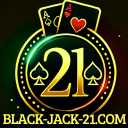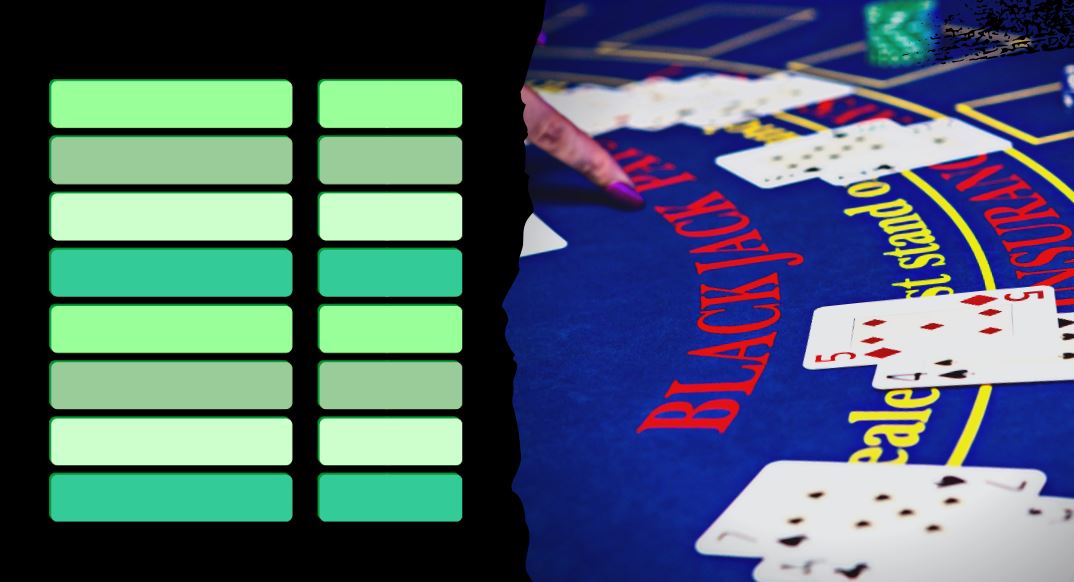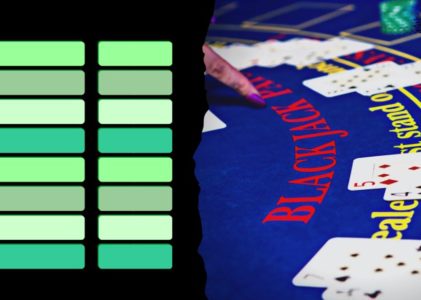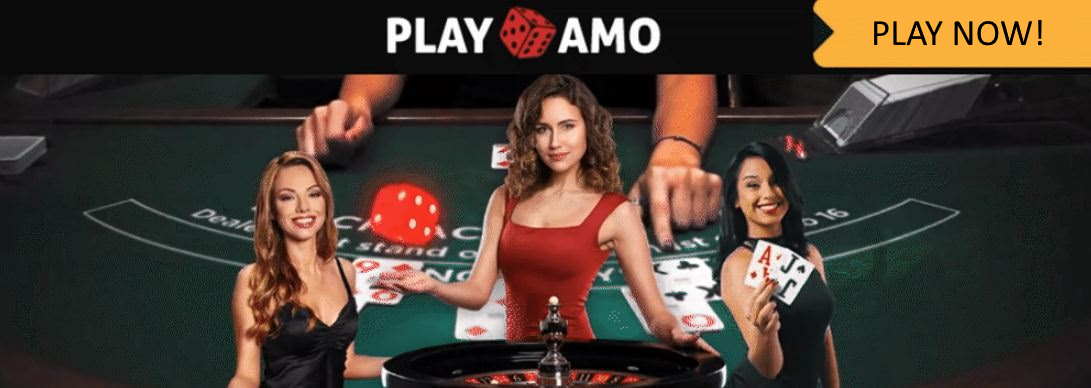The blackjack Table shows the mathematically best possible way to play in every situation on the Blackjack table. Here you can find out when you can draw a card, stop, double or split must!

In the table you can see at a glance what needs to be done:
Where do we play blackjack online?
The best Experience at Black Jack we have in the Playamo Live Casino made. In my opinion, that's where it's at, BEST SELECTION at tables with live dealers and you can train very well for the real casino! Compared to other online Casinos the winnings at Playamo are really paid out and that's why I would recommend the Playamo online casino definitely recommend!
The Playamo Casino has many live tables for blackjack and a quick Payout from Win.

- Draw card (H for hit)
- Stay (S for Stay)
- Verdoppeln (D für Double Down)
- Couples Share (P for pair split)
- Surrender (only available at 16 vs. 10, if this option is allowed)
The Black Jack Table
The blackjack table is divided into three parts:
- Hard Hands
- Soft Hands (card combinations with a Ace)
- Couples
The top line shows which card the dealer is showing. This face-up dealer card is called an up card because you can see the "top".
The left-hand column of the blackjack table shows the sum of your own Maps. This sum is also called the "hand".
So you first look at the top line to see which card the dealer has.
You then go down this column until it coincides with the line of your own hand.
The content of the intersection of the dealer card and your own hand corresponds to the optimal play.
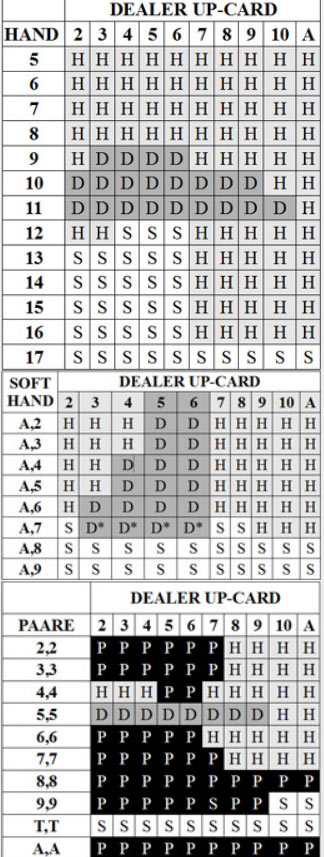
Difference between Hard and Soft Hands
A distinction is made between a hard hand and a soft hand (hard vs soft).
As weiche Hand wird jede Kartenkombination mit einem Ass bezeichnet.

The ace can be counted as either 1 or 11. Depending on which is better for the player.
So if you draw another card with an Ace-6 (17) that is greater than 4, you would have more than 21 and lost. However, the ace is then simply counted as 1, so you have not yet lost.
The perfect blackjack table explained simply
There is no such thing as the perfect blackjack table. It is only ever a recommendation for beginners. Blackjack pros change the way they play depending on the situation. But for beginners it is important to know the House edge of the casino to below 1%.
We can do that by sticking to the perfect blackjack table!
We ask ourselves the following questions in the following order:
SURRENDER: Can / should I give up directly?

Surrender means that you give up your starting hand. In return, you get half of the Use back.
Wenn Sie in einem Casino play, das Surrender erlaubt, haben Sie nur die Möglichkeit, die ersten beiden ausgeteilten Karten aufzugeben. Sie können nicht aufgeben, wenn Sie bereits eine dritte Karte genommen haben.
That's why Surernder is the first thing you need to think about!
Surrender is available in most European casinos, but very few players realise this!
You should always ask if Surrender is allowed in the following situations and if so, make use of it.
- Hard 16 except pair of eights against a 9, 10 or an ace of the dealer.
- Hard 15 against a dealer's 10.
If no surrender is possible or none of the situations mentioned apply, one wonders:
SPLIT: Can / should I share?

The second most important decision is whether or not you can split. This is only an option if your first two cards are a pair or if you have two cards with ten values (such as a Jack and a King).
Double After Split (DAS) means that after splitting a hand, you may double the split hands in favourable situations.
Some casinos do not allow doubling after splitting. However, there are few that do not allow it, so we define Double After Split as the standard.
- Always Aces and split eights
- NEVER split 10s (this of course includes Jacks, Queens and Kings)
- 2s and 3s against 2 to 7 of the dealer
- Pair of 4 only split against dealer's 5 or 6.
- Never divide 5s! Because they add up to 10 and 10 is better doubled!
- Split 6s against dealer's 2 to 6 (2 to 6 on DAS).
- 7s against 2 to 7 of the dealer share
- 9s against 2 to 9 of the dealer (EXCEPT 7!) share.
The following differences occur when Double After Split is NOT allowed:
- Pair of 4 is never split! (not against 5 and 6!)
- 2s and 3s are only split against 4 to 7 of the dealer (not against 2 and 3!).
- 6s are only split against 3 to 6 of the dealer (not against 2!).
If you don't have a pair or two of ten-value cards, you go ahead and ask:
DOUBLE DOWN: Can/should I double?
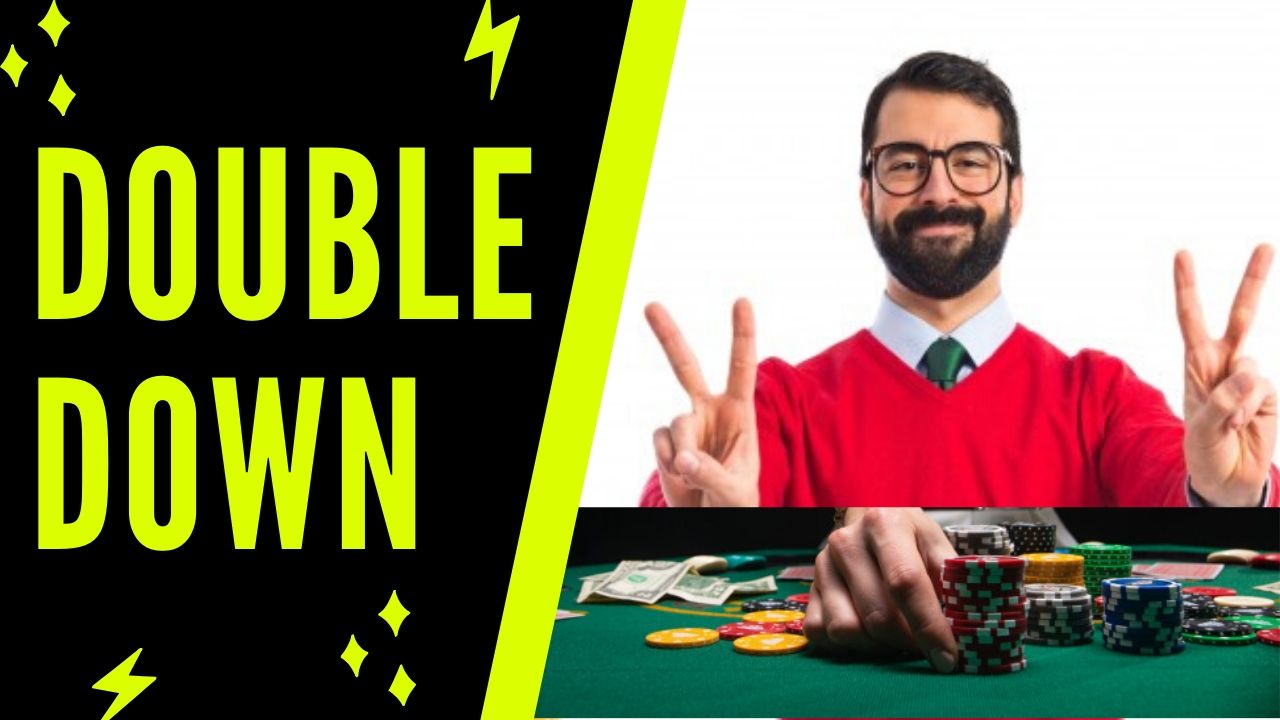
Wenn die Black Jack Tabelle eine Verdoppelung empfiehlt sollte man glücklich sein!
It means that you have to have fairly large Odds has. Of course, this does not mean that you will win every one of these hands!
That's why many beginners are afraid of doubling. However, you have to recognise the greater chances of winning in the long term when doubling up!
Some casinos restrict doubling down on soft hands, for example. Then you can only double with 9, 10 or 11. In this case, your chances of winning are worse and you should no longer play in this casino. Pretty much all Spanish casinos are an example of this.
When doubling, you have to remember these 6 cases:
- 9 against 3 to 6 of the Deaer
- 10 against everything except 10 or the dealer's ace
- 11 against everything except the dealer's ace
- Ace+2 (Soft 13) and Ace+3 (Soft 14) double up against the dealer's 5 and 6.
- Ace+4 (Soft 15) and Ace+5 (Soft 16) double against dealer's 4 to 6
- Ace+6 (soft 17) and Ace+7 (soft 18) double against dealer's 3 to 6
If doubling up is out of the question because you don't have a 9, 10, 11 or a soft hand, then you ask yourself the final, crucial question:
HIT or STAND: Should I hit or stand?

- Always pull to at least 12
- If the dealer has a 2 or 3 draw to at least 13!
- If the dealer has 7 or more, draw until you have at least 17.
- Stop at 17!
- Pull again with soft-17 or less or double!
- Stand still with Soft18 except draw a card against the dealer's 9, 10 or Ace
- Stop from Soft19
If the dealer has to pull at Soft-17...
... the following changes will take effect:
If the dealer has an ace, you also use Surrender with 15, a pair of eights and a 17!
But you can also double up with 11 against the dealer's ace.
You also double with Soft18 (Ace+7) against a 2 from the dealer
and with a soft 19 (ace+8) against a dealer's 6.
Important note about the Black Jack table
There are depending on Black Jack Rules different blackjack tables!
If you don't want to get too involved at the beginning, it's best to use this common Black Jack Strategy Table:
The main distinction here is whether the dealer draws another card with a soft 17 (ace + 6) or stands still.
In most European casinos, the dealer stops with every 17 (i.e. also with Ace + 6).
However, in many Las Vegas casinos, the dealer will then draw another card.
The strategy tables, in which the dealer stands at a soft 17 (Dealer Stands at soft 17), ensure better chances of winning.
The Black Jack table is not enough to win!
This optimal playing style ensures maximum profit and minimum loss over the course of a blackjack career.
In individual cases and also in longer series (up-swing / down-swing), these decisions can of course also lead to losses.
As a player, you are always at a disadvantage in blackjack.
The blackjack table merely ensures that this disadvantage is kept as low as possible.
If you want to win at blackjack in the long term, you have to count cards learn.
The perfect blackjack table
In blackjack, the advantage of a good card counter is around 1%.
So it's not enough to be half-hearted about the blackjack table.
You have to be able to make every decision correctly without hesitation.
This is especially difficult with the soft hands.
I therefore recommend that you make a note of the hands you frequently play incorrectly and pin them in a place that you frequent. E.g. on the toilet, on the fridge, on the alarm clock. This way you will eventually associate this situation with a special place.
If you don't know what to do with Ace-7, then write A+7 in capital letters on a Post-It note and underneath the correct decision with double against 3 to 6. If the dealer stops with Soft17, then even double against 2 to 6.
For example, remember this decision as a "shit decision" and at some point you won't be able to get it out of your head 😉
There are deviations
Die Entscheidungen in dieser Black Jack Tabelle oder jeder anderen Black Jack Tabelle, die du im Internet findest sind nicht dazu da, dass du gewinnst.
These blackjack tables are just to make you lose less!
In fact, most of them give you false information.
You should therefore be prepared to learn the deviations from the basic strategy as quickly as possible.
Only if you can apply the right deviation depending on the game situation will you be successful with blackjack in the long run.
The better you know the blackjack table, the easier the transition to the other variations will be.
